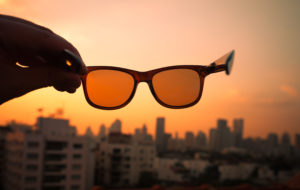

Not all sun lenses are created equal
People wear sunglasses for different reasons. Whether you sport shades as a fashion statement or for the comfort or health benefits, the sunglass lenses you choose often depends on why you want to wear them. Unlike regular sun lenses, polarized lenses have a variety of benefits including reducing glare, eyestrain and better outdoor visual perception.
Benefits of Polarized Lenses:
Reduce glare – On a sunny days, light reflects off of flat surfaces such as cars, asphalt roads and water to create what’s known as blinding glare. Polarized lenses block the reflection and allows you to see more naturally.
Great for water sports – Polarized sun lenses are popular with outdoor enthusiasts due to the reflective nature of water. Polarized sunglasses block glare and allow you to see the water – and not the reflection of the sky.
Reduces eye strain – Squinting in bright sunlight to see colors and objects makes the eye work harder and causes irritation. Polarized lenses neutralize light and create a more natural look, letting your eye comfortably view the world around you.
 How do polarized lenses work?
How do polarized lenses work?
Polarized lenses, like VISION EASE Polarized Lenses, contain a special filter that blocks intense reflected light. The filter is created by lining up molecules to create slots through which light can pass. It’s like Venetian blinds for sunglasses. To filter polarized light, we place a long chain of molecules (hydrocarbons) onto a thin film of polyvinyl acetate (PVA). The film is then heated and stretched, forcing the molecules to align end to end, or become polarized. The film is then dipped into a solution containing a conducting molecule (e.g., iodine). These conducting molecules are now aligned along a pole (polarized) creating a microscopic grid of dark parallel lines that block light waves traveling along a plane that is perpendicular to their length. The film is cut into discs that are molded into the lens with the polarized molecule chains oriented vertically.
Think of a fence and a whip:
Outdoors, as light waves travel away from their source, they vibrate in all directions equally. This is similar to the way motion waves roll down a whip. But rather than the wave traveling on a flat plane, it travels in all directions. When reflected off a flat, shiny surface, the light waves become polarized and align in a side-to-side, horizontal direction. The result is blinding glare. Polarized lenses are like a fence when the whip is fed between the slats of a fence. Only the up and down waves can get through. The side-to-side waves would be blocked. A polarized filter blocks reflected glare in the same way. The horizontal waves are blocked.


Polarized vs. Standard Sunglasses
Non-polarized sun lenses filter all light whether it is horizontal or vertical. By doing so, glare is diminished, but not eliminated. Also, objects don’t look as accurate as they do outside the sun lens. Colors may vary and details are not as crisp. Polarized lenses, by contrast, allow in the vertical component of light, which eliminates glare and allows you to see the world with more natural visual clarity.